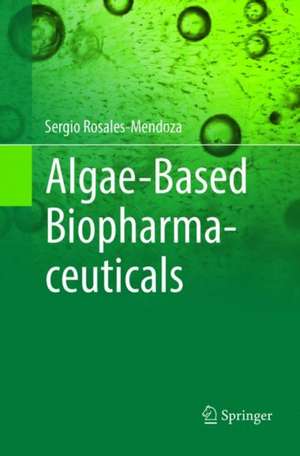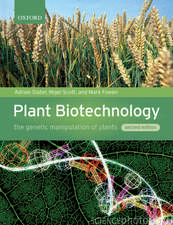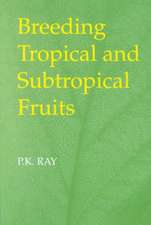Algae-Based Biopharmaceuticals
Autor Sergio Rosales-Mendozaen Limba Engleză Paperback – 30 mai 2018
This book provides a detailed description of the technology as well as an updated outlook of the strides achieved thus far in the field of algae-based biopharmaceuticals. Algae constitute attractive expression hosts for the production of recombinant proteins with medical applications. Among the features that make them attractive candidates are: low cost, fast growth, wide biosynthetic capacity, and absence of human pathogens; which constitute substantial advantages with respect to bacterial and mammalian systems.
First, the features of algae as convenient hosts for the production of BFs are analyzed in terms of production costs, biosynthetic capacity, and safety (Chapter 1). Second, the genetic engineering tools for algae-species are described. Nuclear and chloroplast-based expression approaches are analyzed and compared in terms of biosynthetic advantages, gene expression complexity, and DNA transfer approaches (Chapter 2). In the following sections, chapters 3 to 7, the state of the art on producing distinct types of BFs in algae species is presented. Although this book is mainly focused on BFs, considering that the production of compounds with health-promoting properties are achieved using genetically-engineered algae strains, chapter 8 deals with nutraceuticals. In the ninth chapter, the developments reported thus far are placed in perspective and challenges for the field are discussed. Critical future prospects comprise the following: optimizing large-scale production in bioreactors, implementing glycoengineering approaches, optimizing nuclear expression, exploring new approaches for oral delivery, and implementing regulatory frameworks to accomplish technology transferand regulatory approval of algae-made BFs.
| Toate formatele și edițiile | Preț | Express |
|---|---|---|
| Paperback (1) | 549.89 lei 38-44 zile | |
| Springer International Publishing – 30 mai 2018 | 549.89 lei 38-44 zile | |
| Hardback (1) | 642.51 lei 3-5 săpt. | |
| Springer International Publishing – 31 mai 2016 | 642.51 lei 3-5 săpt. |
Preț: 549.89 lei
Preț vechi: 687.36 lei
-20% Nou
Puncte Express: 825
Preț estimativ în valută:
105.22€ • 109.87$ • 86.89£
105.22€ • 109.87$ • 86.89£
Carte tipărită la comandă
Livrare economică 11-17 aprilie
Preluare comenzi: 021 569.72.76
Specificații
ISBN-13: 9783319812298
ISBN-10: 3319812297
Pagini: 166
Ilustrații: X, 166 p. 47 illus., 22 illus. in color.
Dimensiuni: 155 x 235 mm
Ediția:Softcover reprint of the original 1st ed. 2016
Editura: Springer International Publishing
Colecția Springer
Locul publicării:Cham, Switzerland
ISBN-10: 3319812297
Pagini: 166
Ilustrații: X, 166 p. 47 illus., 22 illus. in color.
Dimensiuni: 155 x 235 mm
Ediția:Softcover reprint of the original 1st ed. 2016
Editura: Springer International Publishing
Colecția Springer
Locul publicării:Cham, Switzerland
Cuprins
The Biopharmaceuticals Field and Algae as Expression Hosts.- Genetic Engineering Approaches for Algae.- Algae-made Vaccines Targeting Human Diseases.- Algae-made Vaccines Targeting Animal Pathogens.- Algae-made Antibodies and Immunotoxins.- Algae-made Cytokines and Growth Factors.- Other Biopharmaceuticals Produced in Algae.- Algae-made Nutraceuticals.- Perspectives for the Algae-made Biopharmaceuticals Field.
Notă biografică
Dr. Sergio Rosales-Mendoza is professor of Biotechnology and has worked in the area of biopharmaceuticals produced in low‐cost platforms for the past 10 years. Over his career, Dr. Rosales-Mendoza has published several scientific refereed articles in international high‐impact scientific journals.
Textul de pe ultima copertă
This book constitutes a key reference on the use of algae in the BFs production field; providing an updated outlook on the achievements accomplished thus far and transmitting a prospective view for this biotechnological application.
This book provides a detailed description of the technology as well as an updated outlook of the strides achieved thus far in the field of algae-based biopharmaceuticals. Algae constitute attractive expression hosts for the production of recombinant proteins with medical applications. Among the features that make them attractive candidates are: low cost, fast growth, wide biosynthetic capacity, and absence of human pathogens; which constitute substantial advantages with respect to bacterial and mammalian systems.
First, the features of algae as convenient hosts for the production of BFs are analyzed in terms of production costs, biosynthetic capacity, and safety (Chapter 1). Second, the genetic engineering tools for algae-speciesare described. Nuclear and chloroplast-based expression approaches are analyzed and compared in terms of biosynthetic advantages, gene expression complexity, and DNA transfer approaches (Chapter 2). In the following sections, chapters 3 to 7, the state of the art on producing distinct types of BFs in algae species is presented. Although this book is mainly focused on BFs, considering that the production of compounds with health-promoting properties are achieved using genetically-engineered algae strains, chapter 8 deals with nutraceuticals. In the ninth chapter, the developments reported thus far are placed in perspective and challenges for the field are discussed. Critical future prospects comprise the following: optimizing large-scale production in bioreactors, implementing glycoengineering approaches, optimizing nuclear expression, exploring new approaches for oral delivery, and implementing regulatory frameworks to accomplish technology transfer and regulatory approval of algae-made BFs.
This book provides a detailed description of the technology as well as an updated outlook of the strides achieved thus far in the field of algae-based biopharmaceuticals. Algae constitute attractive expression hosts for the production of recombinant proteins with medical applications. Among the features that make them attractive candidates are: low cost, fast growth, wide biosynthetic capacity, and absence of human pathogens; which constitute substantial advantages with respect to bacterial and mammalian systems.
First, the features of algae as convenient hosts for the production of BFs are analyzed in terms of production costs, biosynthetic capacity, and safety (Chapter 1). Second, the genetic engineering tools for algae-speciesare described. Nuclear and chloroplast-based expression approaches are analyzed and compared in terms of biosynthetic advantages, gene expression complexity, and DNA transfer approaches (Chapter 2). In the following sections, chapters 3 to 7, the state of the art on producing distinct types of BFs in algae species is presented. Although this book is mainly focused on BFs, considering that the production of compounds with health-promoting properties are achieved using genetically-engineered algae strains, chapter 8 deals with nutraceuticals. In the ninth chapter, the developments reported thus far are placed in perspective and challenges for the field are discussed. Critical future prospects comprise the following: optimizing large-scale production in bioreactors, implementing glycoengineering approaches, optimizing nuclear expression, exploring new approaches for oral delivery, and implementing regulatory frameworks to accomplish technology transfer and regulatory approval of algae-made BFs.
Caracteristici
Provides a detailed description of biopharmaceuticals production as well as an overview of the field of algae-made biopharmaceuticals Analyzes and compares chloroplast expression approaches in terms of gene expression schemes, yields, and post-translational modifications The first comprehensive book in this field





